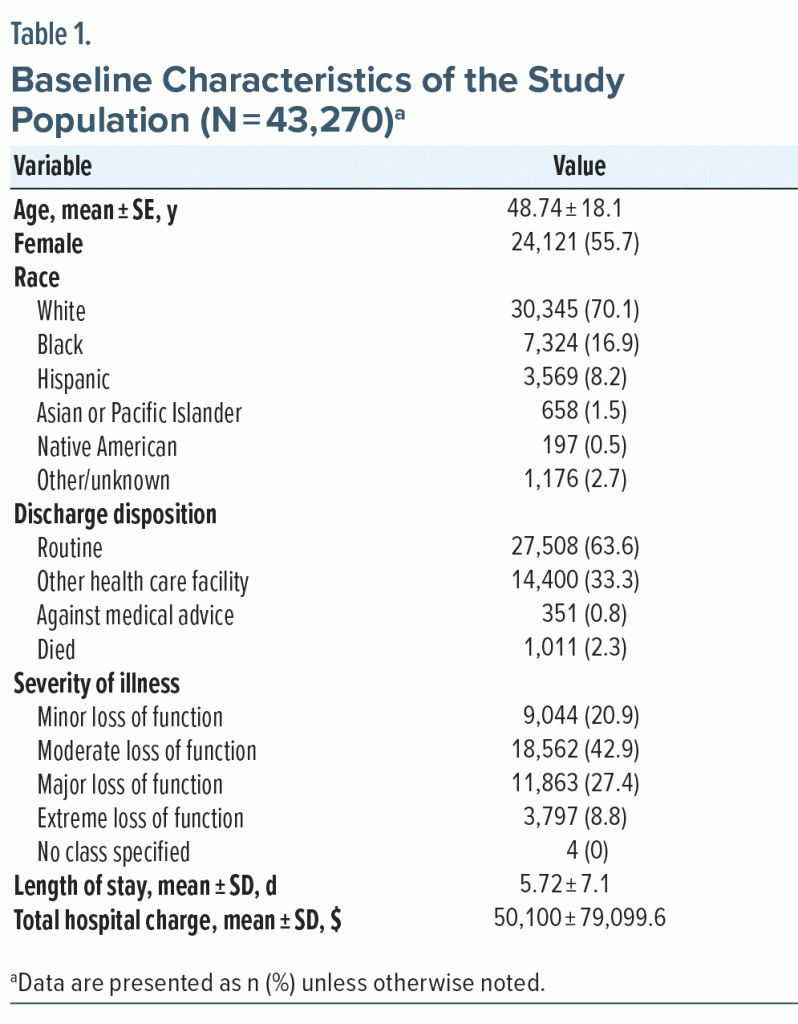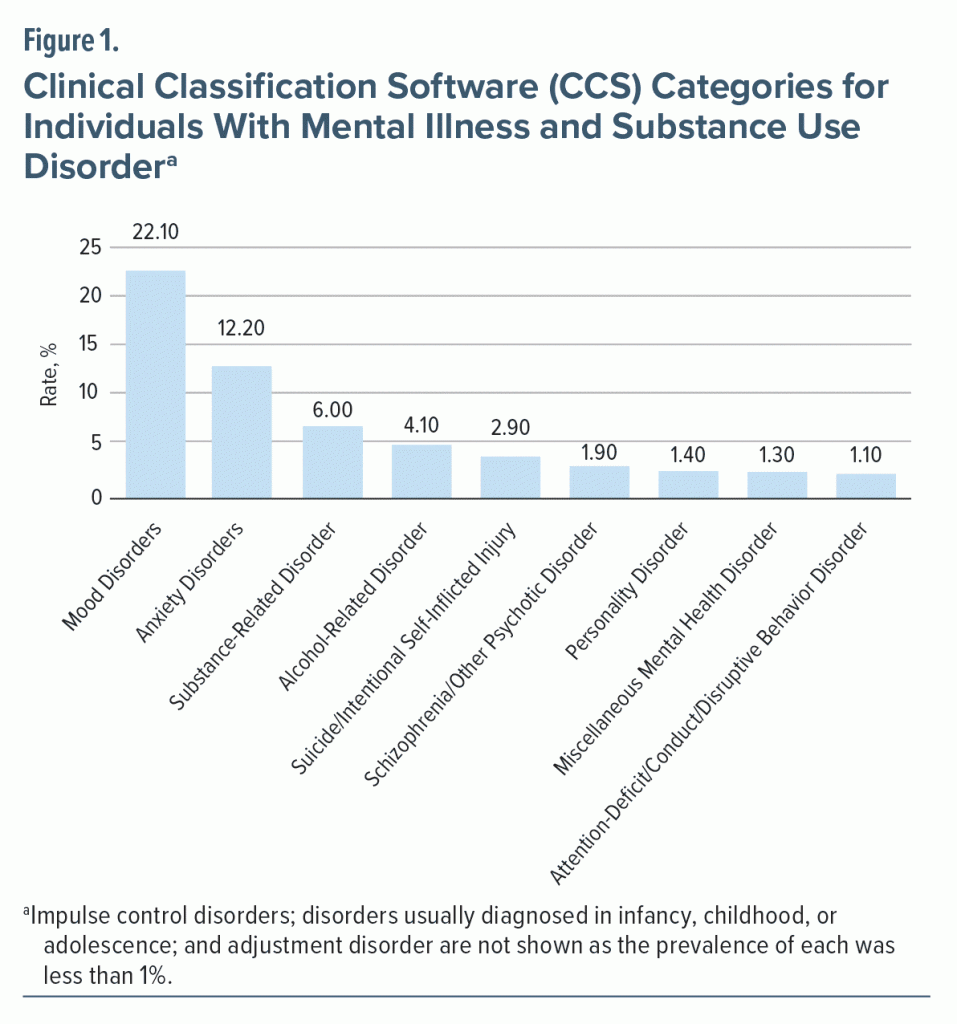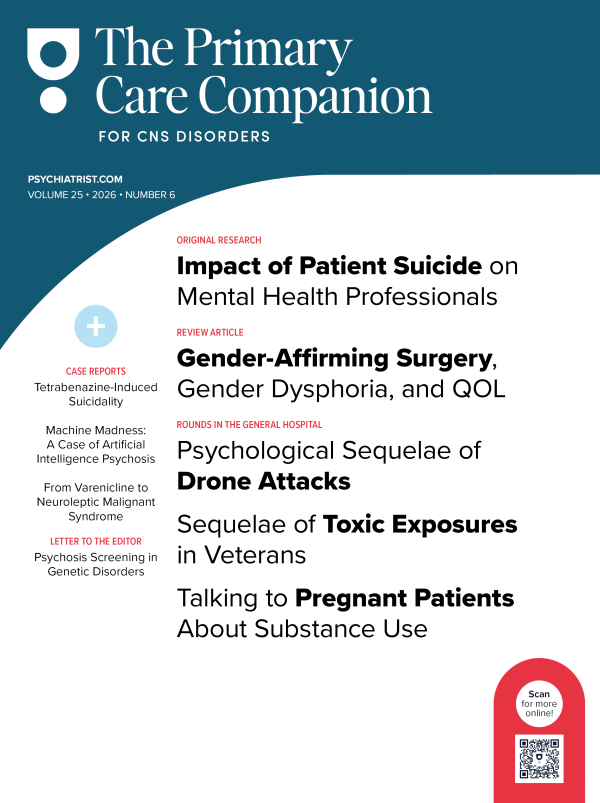ABSTRACT
Objective: To assess the prevalence of psychiatric comorbidities in patients with neurofibromatosis.
Methods: In this cross-sectional study, we used the 2010–2014 National Inpatient Sample database. Patients ≥ 18 years of age with a primary or secondary diagnosis of neurofibromatosis and psychiatric comorbidities were queried.
Results: A total of 43,270 patients with a mean age of 48.7 years (female: 55.7%, White: 70.1%) were included in the study. Overall, psychiatric comorbidities were present in 46.5% of patients; mood disorders (22.1%) and anxiety disorders (12.2%) were the most prevalent comorbidities. Although previous studies report prevalence rates of attention-deficit/hyperactivity disorder in up to 50% of patients with neurofibromatosis, our study found that the rate was much lower at 1.10%. Female sex and non-White race were less associated with psychiatric comorbidities (odds ratio = 0.868 [P = .003] and 0.689 [P < .001], respectively). The moderate-to-extreme loss of function illness severity category was associated with 1.35-times higher odds of having psychiatric comorbidities compared to mild-to-moderate or no loss of function (P < .001). The total length of stay was similar in patients with and without psychiatric comorbidities (mean = 4.98 [95% CI, 4.72–5.24] vs mean = 4.83 [95% CI, 4.60–5.07], respectively; P = .34).
Conclusions: In adult patients with neurofibromatosis, 46.5% were found to have at least one psychiatric comorbid diagnosis. The most frequent psychiatric comorbid disorders were mood disorders and anxiety disorders. Female sex and non-White race predicted a lower likelihood of having a psychiatric disorder.
Prim Care Companion CNS Disord 2023;25(5):23m03514
Author affiliations are listed at the end of this article.
Neurofibromatosis is a group of inherited neurocutaneous disorders that includes neurofibromatosis type 1 (NF1), neurofibromatosis type 2 (NF2), and schwannomatosis. Previous studies have documented high prevalence rates of psychiatric comorbidities in patients with neurofibromatosis.1 Most studies have small sample sizes, making it difficult to generalize the findings.1 Using the National Inpatient Sample (NIS) database, the largest all-payer inpatient care database in the United States, our primary objective was to evaluate the prevalence of psychiatric comorbidities in patients with neurofibromatosis. The secondary objective was to evaluate the predictors associated with psychiatric comorbidities.
METHODS
Data Source
We used the 2010–2014 NIS database from the Healthcare Cost and Use Project (HCUP), sponsored by the Agency for Healthcare Research and Quality. The NIS is the largest all-payer inpatient care database in the United States. It contains clinical and resource use information included in a typical discharge abstract. The NIS contains approximately one-fifth of the sample discharge of 47 states from US community hospitals.2 Discharge level weights are provided to obtain national estimates.
Data Collection
Patients aged 18 years and older with a primary or secondary diagnosis of neurofibromatosis were queried by applying the ICD-9 code in the DXn data element. We used the ICD-9 codes 23770 (neurofibromatosis, unspecified), 23771 (neurofibromatosis, type 1 [von Recklinghausen’s disease]), 23772 (neurofibromatosis, type 2 [acoustic neurofibromatosis]), and 23779 (other neurofibromatosis). In addition, we applied ICD-9 codes based on Clinical Classification Software (CCS) categories of the NIS dataset using previously published literature.3 Patient data were collected on age, sex, race, the severity of the disease, discharge disposition, length of stay, and total hospital charge. Since the sample size was large enough for our objective, we excluded records with missing data. Our primary objective was to evaluate the prevalence of psychiatric comorbidities in patients with neurofibromatosis. The secondary objective was to evaluate the predictors associated with psychiatric comorbidities.
Statistical Analysis
Numbers are presented as counts (percentages) for categorical variables or mean ± SD for continuous variables. The groups were compared using χ2 tests for categorical variables and Student t tests for continuous variables, as appropriate. The discharge level weight was applied to the data set according to the NIS dataset guidelines. To investigate the associations of age, sex, race, and disease severity with psychiatric comorbidities, we performed multivariate logistic regression analyses to calculate the odds ratio (OR) and the corresponding 95% confidence interval (CI). To evaluate the association of psychiatric comorbidities with the length of stay, a 2-level hierarchical regression model with the unique hospital identification number incorporated as a random effect was used. The analysis was performed using SPSS version 26.0 software for Windows (IBM Software Inc; Armonk, New York) and Microsoft Excel 2016. All tests were 2-sided, and a P value < .05 was considered statistically significant.
RESULTS
A total of 43,270 patients (mean age = 48.74 years; female: 24,121 [55.7%]) were included in the study; 70% of patients were White. Almost one-third of the patients were discharged to other health care facilities, and 1,011 (2.3%) of the patients died during their hospital stay. The mean hospital stay was 5.72 days, and the mean cost was $50,100. The baseline characteristics are presented in Table 1.
Overall, 46.5% of patients had psychiatric comorbidities. Mood disorders (22.1%) and anxiety disorders (12.2%) were highly prevalent in the patient population. Furthermore, 24% of the patients had a history of screening for mental health or substance abuse–related conditions. Substance-related disorders were prevalent in 6.0% of the patients, and alcohol-related disorders were present in 4.1% of the patients. Other psychiatric comorbidities are presented as a bar diagram in Figure 1.
In the assessment of factors associated with psychiatric comorbidities, age, female sex, moderate-to-extreme loss of function according to the severity of the disease, and non-White race were predictors of psychiatric comorbidities (Table 2). In the multivariate analysis, age did not show any association. Female sex and non-White race were associated with fewer psychiatric comorbidities (OR = 0.868 [P = .003] and 0.689 [P < .001], respectively). The moderate-to-extreme loss of function illness severity category was associated with 1.347-times higher odds of having psychiatric comorbidities compared to mild-to-moderate or no loss of function (P < .001). The total length of stay was similar in patients with and without psychiatric comorbidities (mean = 4.98 [95% CI, 4.72–5.24] vs mean = 4.83 [95% CI, 4.60–5.07], respectively; P = .34).
DISCUSSION
Reports of neurofibromatosis in the literature first appeared during the 13th and 14th centuries. Friederich von Recklinghausen is credited with discovering and naming the disorder in 1882. As noted, neurofibromatosis is classified into 3 types: NF1, NF2, and schwannomatosis. About 50% of cases of NF1 and NF2 and 85% of schwannomatosis have a spontaneous mutation. The rest of the cases have an autosomal dominant pattern of inheritance.4,5
NF1 is the most common type, seen in approximately 96% of all cases.4–7 The incidence of NF1 is approximately 1:2,700, that of NF2 is 1:33,000, and that of schwannomatosis is 1:40,000.5,8 NF1 has an equal distribution in both sexes and across different races.4 The pathogenesis of NF1 is related to abnormalities of the NF1 gene located on chromosome 17q11.2 that codes for neurofibromin, NF2 is related to abnormalities of the NF2 gene located on chromosome 22 that encodes for schwannomin, and schwannomatosis is related to the SMARCB1 gene located on chromosome 22.7–12 NF1 can appear after birth, but it usually occurs between the ages of 10 and 15 years. NF2 and schwannomatosis are rare in children and usually occur in individuals in their 20s and 30s.7
The typical presentation of NF1 includes dermatologic (café-au-lait macules, axillary and/or inguinal freckling), ocular (iris hamartomas, also known as Lisch nodules), and neurologic (mainly neurofibromas) components.13 NF2 presents most frequently with tumors of the nervous system: schwannomas, meningiomas, and spinal tumors; eye involvement: cataracts and hamartomas; and skin lesions: cutaneous and subcutaneous tumors.14,15 Schwannomatosis presents with schwannomas: tingling sensation, numbness, weakness, or neurologic dysfunction.
Previous studies have documented high prevalence rates of psychiatric comorbidities in patients with neurofibromatosis.1 Most studies have small sample sizes, making it difficult to generalize the findings.1 However, patients with neurofibromatosis are more likely to experience depression, anxiety, lower levels of self-esteem, and higher levels of perceived stress.9
Using the NIS database, the largest all-payer inpatient care database in the United States, we report that 46.5% of neurofibromatosis patients have at least one psychiatric comorbid diagnosis. The most frequent psychiatric comorbid disorder was mood disorders (22.1%), followed by anxiety disorders (12.2%), substance-related disorders (6.0%), and alcohol-related disorders (4.1%). The results of our study corroborate the results of previous studies on the prevalence of depression and anxiety.16 Previous studies report prevalence rates of attention-deficit/hyperactivity disorder of about 50% in patients with NF1.10 In our study, we found that the rate was much lower at 1.10%. Other comorbidities that can present include schizophrenia and other psychotic disorders (1.9%), personality disorders (1.4%), and other mental health disorders (1.3%).
Female sex and non-White race were inversely related to having psychiatric comorbidity, while age was not found to be a risk factor. Previous studies have reported a younger age and a greater predisposition to develop anxiety disorder among individuals with neurofibromatosis.11 The prevalence of psychiatric comorbidities was proportional to the severity of the disease. In previous studies, patients with neurofibromatosis with perceived higher disability and hopelessness compared to controls were reported to have an increased risk of suicidal ideation.12 There were no statistically significant differences in discharge to other health care facilities, mortality during hospitalization, or average cost during hospitalization.
To our knowledge, this study is the first to provide information on the disposition, mortality during hospitalization, and average cost during hospitalization in neurofibromatosis patients. The sample size for our study is considerably larger than those of previous studies on psychiatric comorbidities in neurofibromatosis.
The limitation of the use of hospitalization (not patients) as an analytic unit is that it cannot be generalized to all neurofibromatosis patients. The NIS dataset depends on proper ICD coding, which could result in the underrepresentation of certain diseases or procedures. Furthermore, we evaluated the diagnosis of neurofibromatosis from the dataset, but there may also be other comorbid diagnoses that can influence the analysis of length of stay or hospital charge. Additionally, it is not possible to validate individual ICD codes since the database used is a de-identified database. We recommend that future research examine the influence of psychiatric comorbidities on clinical data.
CONCLUSIONS
Few clinics in the United States specialize in caring for patients with neurofibromatosis. Because the disorder affects both physical and mental health, physicians must be vigilant for signs of psychological distress as well. Treating neurofibromatosis requires a multidisciplinary approach to improve the patient’s quality of life.6
Article Information
Published Online: October 3, 2023. https://doi.org/10.4088/PCC.23m03514
© 2023 Physicians Postgraduate Press, Inc.
Submitted: February 19, 2023; accepted May 22, 2023.
To Cite: Brar KS, Trivedi C, Kaur N, et al. Prevalence of psychiatric comorbidities in patients with neurofibromatosis. Prim Care Companion CNS Disord. 2023;25(5):23m03514.
Author Affiliations: Mindpath Health, Manteca, California (Brar); Department of Psychiatry, Texas Tech University Health Sciences Center, Odessa/Permian Basin, Texas (Trivedi, Adnan); Department of Pathology, University of Mississippi Medical Center, Jackson, Mississippi (Kaur); Department of Psychiatry, Penn State University, Hershey, Pennsylvania (Patel); Department of Psychiatry, Piedmont Hospital, Macon, Georgia (Beg); Department of Psychiatry, Indiana University Ball Memorial Hospital, Muncie, Indiana (Qureshi); Department of Psychiatry, Boston Children’s Hospital/Harvard Medical School, Boston, Massachusetts (Mansuri); Vituity, Los Angeles, California (Ibrahim); Central State Hospital, Milledgeville, Georgia (Zafar).
Corresponding Author: Kanwarjeet Singh Brar, MD, 142 Grant Ave #142, Manteca, CA 95336.
Relevant Financial Relationships: None.
Funding/Support: None.
Previous Presentation: Poster presented at the American Psychiatric Association annual meeting; virtual; May 1–3, 2021.
Additional Information: The original dataset for the National Inpatient Sample is available at https://www.hcup-us.ahrq.gov/db/nation/nis/nisdbdocumentation.jsp.
ORCID: Kanwarjeet S Brar: https://orcid.org/0000-0002-1121-849X
Clinical Points
- Few clinics in the United States specialize in caring for patients with neurofibromatosis.
- Since neurofibromatosis affects both physical and mental health, clinicians must screen for signs of psychological distress as well.
- Female sex and non-White race were associated with fewer psychiatric comorbidities.
References (16)

- Belzeaux R, Lançon C. Neurofibromatose de type 1: troubles psychiatriques et altération de la qualité de vie. (Neurofibromatosis type 1: psychiatric disorders and quality of life impairment) Presse Med. 2006;35(2 Pt 2):277–280. PubMed CrossRef
- HCUP-US NIS overview. HCUP-US. AHRQ website. Accessed August 2020. https://www.hcup-us.ahrq.gov/nisoverview.jsp
- Clinical Classifications Software Refined (CCSR). Healthcare Cost and Utilization Project (HCUP). March 2021. Agency for Healthcare Research and Quality, Rockville, MD. Accessed August 1, 2020. www.hcup-us.ahrq.gov/toolssoftware/ccsr/ccs_refined.jsp
- Evans DG. Neurofibromatosis type 2. Handb Clin Neurol. 2015;132:87–96. PubMed CrossRef
- Mansukhani SA, Butala RP, Shetty SH, et al. Familial schwannomatosis: a diagnostic challenge. J Clin Diagn Res. 2017;11(2):RD01–RD03. PubMed
- Le C, Bedocs PM. Neurofibromatosis. In: StatPearls. Treasure Island, FL: StatPearls Publishing; January 2022. Accessed November 2022. https://www.ncbi.nlm.nih.gov/books/NBK459329/
- Ghalayani P, Saberi Z, Sardari F. Neurofibromatosis type I (von Recklinghausen’s disease): a family case report and literature review. Dent Res J (Isfahan). 2012;9(4):483–488. PubMed
- Antinheimo J, Sankila R, Carpén O, et al. Population-based analysis of sporadic and type 2 neurofibromatosis-associated meningiomas and schwannomas. Neurology. 2000;54(1):71–76. PubMed CrossRef
- Gutmann DH, Ferner RE, Listernick RH, et al. Neurofibromatosis type 1. Nat Rev Dis Primers. 2017;3:17004. PubMed CrossRef
- Mautner VF, Kluwe L, Thakker SD, et al. Treatment of ADHD in neurofibromatosis type 1. Dev Med Child Neurol. 2002;44(3):164–170. PubMed CrossRef
- Rouleau GA, Merel P, Lutchman M, et al. Alteration in a new gene encoding a putative membrane-organizing protein causes neuro-fibromatosis type 2. Nature. 1993;363(6429):515–521. PubMed CrossRef
- Hulsebos TJ, Kenter SB, Jakobs ME, et al. SMARCB1/INI1 maternal germ line mosaicism in schwannomatosis. Clin Genet. 2010;77(1):86–91. PubMed CrossRef
- DeBella K, Szudek J, Friedman JM. Use of the national institutes of health criteria for diagnosis of neurofibromatosis 1 in children. Pediatrics. 2000;105(3 Pt 1):608–614. PubMed CrossRef
- Parry DM, Eldridge R, Kaiser-Kupfer MI, et al. Neurofibromatosis 2 (NF2): clinical characteristics of 63 affected individuals and clinical evidence for heterogeneity. Am J Med Genet. 1994;52(4):450–461. PubMed CrossRef
- Evans DG, Huson SM, Donnai D, et al. A clinical study of type 2 neurofibromatosis. Q J Med. 1992;84(304):603–618. PubMed
- Cohen JS, Levy HP, Sloan J, et al. Depression among adults with neurofibromatosis type 1: prevalence and impact on quality of life. Clin Genet. 2015;88(5):425–430. PubMed CrossRef
Please sign in or purchase this PDF for $40.





